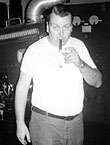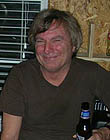|
|
This topic comprises 3 pages: 1 2 3
|
|
Author
|
Topic: Booth Electrical Loads
|
Barry Floyd
Phenomenal Film Handler

Posts: 1079
From: Lebanon, Tennessee, USA
Registered: Mar 2000
|
 posted 01-03-2003 11:38 AM
posted 01-03-2003 11:38 AM





I've got to submit to our electrical engineer who is designing the "Power layout" for our drive-in, a table of "electrical loads" for our building, and had a question about the booth load requirements.
I've got plenty of power available from the street, as 3 phase power is already run to the site at the edge of the road.
My current lamphouse in storage is an 4kw ORC, but have considered replacing it with either a Strong or a Xenex II. I noticed when I removed my ORC from it's former booth that it had both 3 phase running to the power supply, and a 120v circuit run to the lamphouse controls... or something like that. I've got to tell my electrical engineer what size circuits to install and I don't have a clue.
My projector is a Simplex XL with a RCA 9030 soundhead. I was figuring a 30amp 120v dedicated circuit would handle the projector, and another 20amp 120v dedicated circuit to cover the platter and MUT.
Our theatre will end up being a twin screen by the beginning of 2004, but will open in May of 2003 with one screen. I'm having the engineer size the service entrance and panel board to accomodate both screens for ease of expansion in the future, but I need to tell him what to put in there now.
Any help would be appreciated....
| IP: Logged
|
|
|
|
|
|
Jon Bartow
Master Film Handler
Posts: 287
From: Massachusetts
Registered: Nov 1999
|
 posted 01-03-2003 12:56 PM
posted 01-03-2003 12:56 PM




Three phase delta is the kind you want. (all three legs are usable by single phase devices, as all three legs are stable) Not many places still have three phase wye but they are out there. If you have a three phase wye setup then you will find that every third slot for a breaker in your panel will be useless except for three phase devices.
Is your projector motor three phase? or 220v? or 110v? It makes a big difference in the amp load required.
Are you running a 70v amp for field speakers? if so big amps can be very power hungry.
Try very hard (beg and plead if you have to) to have all of your sound equipment on the same phase and don't let them put any dimmers or big motors on that phase either (projector motor, HVAC, ice machine compressors, etc). It will save many potectial problems down the road. Also you want an isolated ground for the booth, not grounded through the conduit downstairs through the concession stand, but a good ground from the panel in the booth.
20 amps is usaully enough for a 110v or 220v projector, they are usually only 1/4-1/2hp motors.
Make sure your electrician uses a breaker panel that is big enough to have several more circuits installed (if you are adding a screen later, than you will probably add another breaker panel, it simplifies things a bit. make sure your electricians plan for that too.
Also, depending on the type of breaker panel, it can sometimes be a bit of a challenge to get replacement breakers. It would be a good idea to have a spare of each type/size used. They can even put the spare breakers in an unused slot in the panel.
John is very wise to caution you about lightening protection. field speakers on poles are excellent lightening rods as is a building alone in the middle of a field. Make sure the field speaker lines are well protected.
As has been said, provide your elec. eng. with all of the equipment specs and s/he will be able to plan accordingly. My guess is that a 500-600amp three-phase (delta) will more than suffice for your current (pun very intended ![[Roll Eyes]](rolleyes.gif) ) and future needs. ) and future needs.
Jonathan
| IP: Logged
|
|
|
|
Barry Floyd
Phenomenal Film Handler

Posts: 1079
From: Lebanon, Tennessee, USA
Registered: Mar 2000
|
 posted 01-03-2003 03:48 PM
posted 01-03-2003 03:48 PM





Ian, you never cease to amaze me the long lists of categories you can come up with, and all very accurate. On a side note to this topic, I took the list of "operating expenses" you listed in the "Business Plan" topic a year or so ago, and incorporated them into our cash flow plan for the drive-in. I had my loan approved for the purchase and construction of the drive-in in less than a week. My banker said, "For someone who's never been in this business before, you sure have your expense categories very well detailed."
John and Jon had mentioned "lightning protection" for the booth, I'm assuming for stray random strikes in the field running in on the field speakers. We will not have any field speakers... now days they're just too costly to maintain, and also expensive to install.
I've got an FM stereo transmitter that runs at a 1/2 watt that won't broadcast the signal much further than the property boundaries.
| IP: Logged
|
|
John Pytlak
Film God

Posts: 9987
From: Rochester, NY 14650-1922
Registered: Jan 2000
|
 posted 01-03-2003 04:00 PM
posted 01-03-2003 04:00 PM





Your projection room / concession area sitting in the middle of an open field is a nice target for lightning. Protect those buildings, and also protect against the damage a lighting hit will have if it gets into your power lines (e.g., if you have field lights at the top of your screen, they are likely to get hit, with the surge knocking out some of your equipment).
My home has lightning rods, and a surge protector where the power line enters the house. My phone, cable, and antenna lines all have "lightning arresters", with a solid path to an outside ground. Four houses in our hilltop neighborhood have been hit, with varying levels of damage.
I've lived through enough lightning storms sitting in a drive-in booth to appreciate the need for lightning protection. ![[Eek!]](eek.gif)
| IP: Logged
|
|
|
|
|
|
|
|
|
|
|
|
|
|
Gordon Bachlund
Jedi Master Film Handler

Posts: 696
From: Monrovia, CA, USA
Registered: Aug 1999
|
 posted 01-03-2003 05:40 PM
posted 01-03-2003 05:40 PM





Today the most common three-phase electrical services are “wye” connected, usually 120/208V and 277/480V in the US. Thus, electrical panels will have three “hot” buses (phases A, B and C) and a neutral bus, plus a separate ground bus. Any phase to neutral connection will afford the lower voltage (120V or 277V), while any phase to phase connection will afford the higher voltage (208V or 480V single phase), and while any connection to all three phases will afford actual three-phase power (208V or 480V 3-phase).
Some utilities still employ an older scheme that was derived from a delta connection of three single-phase transformers, one larger than the other two, to afford both 120/240V single phase (from the larger transformer which has a center tap for the neutral), or 240V three-phase from all three. This enabled a single bank of pole-mounted transformers to serve a building’s lighting load at 120/240V through one meter, and a building’s three-phase “power” load through another meter. Usually the rate was a bit lower for the “power” load. I have seen this in countless neighborhood theatres in the Los Angeles area in the 50s and 60s. One house in which I worked was served 125VDC by the local utility, and the DC service was used for the projection lamps. When I asked why the utility was still selling DC, I was told that some older downtown office buildings had DC services for their elevators, obviously pre-dating the more modern Ward-Leonard style motor-generator drives.
Barry, those who have advised that you provide the electrical engineer with a complete list of known (and future) loads are correct. He will especially appreciate seeing copies of specifications and manuals. He will then perform such calculations as will ensure that your installation is proper and safe, to say nothing of meeting code. And, yes, most inspectors will look for UL labels, dedicated “green” grounding conductors, transient voltage surge suppressors, proper lightning protection where required, and other safety related practices.
| IP: Logged
|
|
|
|
|
|
All times are Central (GMT -6:00)
|
This topic comprises 3 pages: 1 2 3
|
Powered by Infopop Corporation
UBB.classicTM
6.3.1.2
The Film-Tech Forums are designed for various members related to the cinema industry to express their opinions, viewpoints and testimonials on various products, services and events based upon speculation, personal knowledge and factual information through use, therefore all views represented here allow no liability upon the publishers of this web site and the owners of said views assume no liability for any ill will resulting from these postings. The posts made here are for educational as well as entertainment purposes and as such anyone viewing this portion of the website must accept these views as statements of the author of that opinion
and agrees to release the authors from any and all liability.
|

 Home
Home
 Products
Products
 Store
Store
 Forum
Forum
 Warehouse
Warehouse
 Contact Us
Contact Us




 Printer-friendly view of this topic
Printer-friendly view of this topic








![[Eek!]](eek.gif)
![[Roll Eyes]](rolleyes.gif) ) and future needs.
) and future needs.


![[thumbsup]](graemlins/thumbsup.gif)







